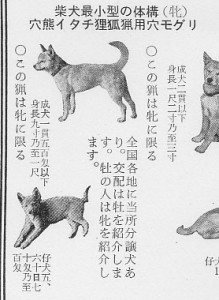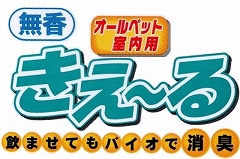Basic knowledge of the Mameshiba
The longest-established kennel specializing in Mameshiba in Japan welcomes customers from all over the world.
The Soaring Period of Japanese Dogs
Many Western dogs entered Japan with the opening of the country during the Meiji Restoration in the late 19th century.
Since Japanese dogs were kept outside, they gradually became crossbred due to Western dogs that ran away or were abandoned.
Many urban dogs are said to have become crossbred.
The sense of crisis that Japan’s unique purebreds would disappear if the situation did not change led to the establishment of preservation societies in various regions.
This is where the crossbreeding finally came to a halt, but even dogs in urban areas that were considered to be purebreds could not trace their ancestry back then because they did not have pedigrees.
Therefore, efforts have been made to increase the number of purebreds by conducting “yamadashi” (bringing out dogs from areas in the mountains where Western dogs have not entered) and controlling pedigrees, and priority has been given to recovering the number of dogs.
At the same time, Shiba Inus recognized as excellent by the seniors among the Sanin Shiba at the exhibition were brought to the Shinshu area to be bred, and based on them, local Shiba from each area were crossed to recover the number of Shiba Inus.
Therefore, many of the ancestors of the current Shiba are a crossbreed of the Shinshu Shiba and the Sanin Shiba. (For more information, please refer to books written by senior members.)
On the other hand, some species have become extinct in local shibas that were not recognized as superior.
The ancestor of the “Naka go,” which is considered the ancestor of the excellent Shiba Inu, is the Sekishu Shiba, but the Sekishu Shiba is extinct.
Dr. Tanabe concludes that a close examination of the genetic makeup of the local shibas of the time would suggest that they were different species, each evolving uniquely in its own right.
It is also a fact that the independent local Shiba of each region were lumped together as Shiba Inu and created the modern Shiba, even though they were originally different breeds.
Such a period of confusion is the period of wisdom in the Japanese dog.
Preservation Society
Masanobu, the father of the current owner and founder of Hozanso kennel, has been searching all over Japan for small Shiba Inus, which are considered out of standard by the Japanese dog preservation society, to preserve and breed them.
Dogs that did not meet the standards were not evaluated simply because they were “small,” even if they were of excellent quality, and such lines were excluded from many breeders.
The only reason is that they do not meet the standard of body height set by the preservation society.
There were many large and small Shiba Inus, even among the purebreds of Yamadashi.
Although there has always been diversity in Japanese dogs, the standard height set by the Nihonken Preservation Society became a bottleneck, and dogs that did not meet the standard were destined to be eliminated, despite the purpose of preservation.
In addition to the Nihonken Hozonkai (Japanese Dog Preservation Society), various other preservation societies were formed to protect these diverse Japanese dogs.
◎Nihonken Hozonkai
◎Hokkaidoken Hozonkai
◎Akitaken Hozonkai
◎Kaiken Aigokai
◎Shikokuken Hozonkai
◎Kishuken Hozonkai
◎Ryukyuken Hozonkai
(The following is a preservation society specializing in Shiba Inu)
◎Shibaken Hozonkai
◎Minoshiba Hozonkai
◎Saninshiba Hozonkai
◎Kawakamiken Hozonkai
◎Mameshiba ikuseifukyuukai
In the past, each Shiba Inu had its own regional name.
There is a history of various preservation societies that have come and gone in the process of Shiba Inu preservation.
Dogs eliminated to protect them.
Elimination of diversity for the sake of species preservation.
Without thinking too hard about such contradictions, a Kyoto dog lover began collecting and preserving small Shibas around 1950 with the aim of protecting such dogs even if they did not meet the standards set by the association.
It was there that the father of the current owner and founder of Hozanso, Masanobu, met Mameshiba (small Shiba).
Now that person has passed away, and that kennel has given up their dogs once, so our kennel, Hozanso, is the only kennel that has many pure Mameshiba (small Shiba) bloodlines.
Breeding only from the Kyoto bloodline would have quickly resulted in a thickening of the bloodline, so Masanobu traveled to mountainous areas throughout Japan to collect small purebred Shiba Inus, as if he was touring the paths taken by his predecessors.
We visited many, many exhibitions of Nihonken Hozonkai to search for “the bloodline that breeds the little Shiba Inu”.
Sometimes we were reprimanded, “If you are a member, don’t do anything that is out of compliance with the purpose of the association!”
“There are Shiba Inus that are small in stature.”
I was told that there were Shiba Inus that produced small Shiba, so I visited them and explained, “I want to collect small Shiba and protect the small Shiba bloodline.”
However we were told, “Are you here to make fun of the fact that even if my dogs are of good quality, they will only be small?” “I am having a hard time with small Shiba, and you are defending small Shiba! So we turned away.
Height is also an important factor in receiving a high evaluation at an exhibition. No matter how much you polish the quality of your dog, if it is not tall enough, it will be a waste of time.
We went back and forth to them who finally gave us a puppy and a small female dog.
An Old Grandmother’s Story
Do you know anyone who has a small Shiba? I asked an old woman in the mountains of the Shinshu region of Japan.
“I used to see a lot of them, but lately I’ve only seen big ones. There used to be a lot of them, but lately I only see big ones. Men like big dogs, so they make them bigger.
As they get bigger, they eat more food, and if the prey is small, they eat it all by themselves without handing it over to humans.”
I was taught that houses like farmers used small Shiba Inus for hunting small items.
We also heard many other stories as follows.
“In the early Showa period(1926~), men were so desperate for power and honor to produce good dogs that they ended up with dogs that all looked alike.”
“In the old days, watching over the birth of a farm dog was a woman’s job, like a birth mother, which meant that women were more knowledgeable.”
“There had always been a small Shiba, affectionately called “Koshiba(Ko means small),” since that grandmother’s childhood.”
“Even a small Shiba Inu was effective enough to ward off fierce beasts (bears and wild boars).”
“Small Shiba Inu for hunting were distributed among dual-use farmers as a kind of trade barter.”
There may have been many fixed Koshiba (small shiba) in the Meiji (1868-1912) and Taisho (1912-1926) eras, as this was an old story we heard around 1980.
In fact, there is even an advertisement in old hunting magazines for the sale of “Anagura(cave) hunting, Shakushiba (30.3 cm)(“Shaku” is approx. 30.3 cm).
Depending on the region, the small shiba was called Koshiba, Shakushiba, or some other familiar name.
*Source of image: “Shuryoukai(hunting world)” The Shakushiba was traded as a cave hound.
The vanishing blood of Koshiba
With time, however, Koshiba (small shiba) gradually disappeared.
The reasons for this are that as distribution networks developed and meat became available even in mountainous areas, the need for “hunting” diminished, and Koshiba became larger (standardized).
The small Shiba became large to meet the standards of the Nihonken Hozonkai, and the large Shiba became small to meet the standards of the Nihonken Hozonkai.
So diversity has been lost.
There are four different lines of poodles, even though they are the same breed.
Standard Poodle over 45cm
Medium Poodle from 35 to 45 cm
Miniature Poodle from 28 to 35 cm
Toy Poodle from 24 to 28 cm
Mameshiba of Setsuju Hozanso has a history (solid pedigree) of over 60 years.
Many of Hozanso’s ancestral dogs are registered with the Nihonken Hozonkai.
Just because they are small, we were even told “Don’t use them for breeding!” However, in consideration of the diversity of dogs, we launched the “Nihonken Mameshiba Hozon Ikusei Hukyukai” (Japanese Mameshiba Preservation and Breeding Association).
FAQs about exporting a Mameshiba Inu
Terms and conditions of the contract for the sale of living organisms
Appropriate amount of food for the Mameshiba
Preparation for acceptance (training)
Basic knowledge of the Mameshiba Inu (current page)





















